| History |
Creation and Development
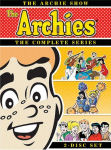 In 1968, Fred Silverman, executive in charge of children's programming for the CBS network, was looking for a show that would revitalize his Saturday morning line-up and please the watchdog groups at the same time. The result was The Archie Show, based upon Bob Montana's teenage humor comic book Archie. Also successful were the musical numbers The Archies performed during each program (one of which, "Sugar, Sugar", was the most successful Billboard number-one hit of 1969). Silverman was eager to expand upon this success, and contacted producers William Hanna and Joseph Barbera about possibly creating another show based around a teenage rock-group, but with an extra element: the kids would solve mysteries in-between their gigs. Silverman envisioned the show as a cross between the popular I Love a Mystery radio serials of the 1940s and the popular early 1960s TV show The Many Loves of Dobie Gillis. In 1968, Fred Silverman, executive in charge of children's programming for the CBS network, was looking for a show that would revitalize his Saturday morning line-up and please the watchdog groups at the same time. The result was The Archie Show, based upon Bob Montana's teenage humor comic book Archie. Also successful were the musical numbers The Archies performed during each program (one of which, "Sugar, Sugar", was the most successful Billboard number-one hit of 1969). Silverman was eager to expand upon this success, and contacted producers William Hanna and Joseph Barbera about possibly creating another show based around a teenage rock-group, but with an extra element: the kids would solve mysteries in-between their gigs. Silverman envisioned the show as a cross between the popular I Love a Mystery radio serials of the 1940s and the popular early 1960s TV show The Many Loves of Dobie Gillis.
 Hanna and Barbera passed this task along to two of their head storymen, Joe Ruby and Ken Spears, and artist/character designer Iwao Takamoto. Their original concept of the show bore the title Mysteries Five, and featured five teens (Geoff, Mike, Kelly, Linda, and Linda's brother "W.W.") and their dog, Too Much, who were all in a band called "The Mysteries Five" (even the dog; he played the bongos). When "The Mysteries Five" weren't performing at gigs, they were out solving spooky mysteries involving ghosts, zombies, and other supernatural creatures. Ruby and Spears then had to decide what to make their dog. At first, they chose between a large cowardly dog, and a small fiesty dog. When the former was chosen, then the options became a large goofy Great Dane or a big shaggy sheepdog. After consulting with Barbera on the issue, Too Much was finally set as a Great Dane, primarily to avoid a direct correlation to The Archies (who had a sheepdog, Hot Dog, in their band). Ruby and Spears had feared the Great Dane would be too similar to the comic strip character Marmaduke, but Barbera assured them it would not be a problem. Hanna and Barbera passed this task along to two of their head storymen, Joe Ruby and Ken Spears, and artist/character designer Iwao Takamoto. Their original concept of the show bore the title Mysteries Five, and featured five teens (Geoff, Mike, Kelly, Linda, and Linda's brother "W.W.") and their dog, Too Much, who were all in a band called "The Mysteries Five" (even the dog; he played the bongos). When "The Mysteries Five" weren't performing at gigs, they were out solving spooky mysteries involving ghosts, zombies, and other supernatural creatures. Ruby and Spears then had to decide what to make their dog. At first, they chose between a large cowardly dog, and a small fiesty dog. When the former was chosen, then the options became a large goofy Great Dane or a big shaggy sheepdog. After consulting with Barbera on the issue, Too Much was finally set as a Great Dane, primarily to avoid a direct correlation to The Archies (who had a sheepdog, Hot Dog, in their band). Ruby and Spears had feared the Great Dane would be too similar to the comic strip character Marmaduke, but Barbera assured them it would not be a problem.
Takamoto consulted a studio colleague who happened to be a breeder of Great Danes. After learning the characteristics of a prize-winning Great Dane from her, Takamoto proceeded to break most of the rules and designed Too Much with overly bowed legs, a double-chin, and a sloped back, among other abnormalities.
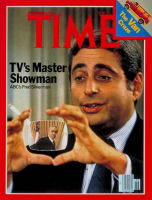 By the time the show was ready for presentation by Silverman, a few more things had changed: Geoff and Mike were merged into one character called "Ronnie" (later renamed "Fred", at Silverman's behest), Kelly was renamed to "Daphne", Linda was now called "Velma", and Shaggy (formerly "W.W.") was no longer her brother. Also, Silverman, not being very fond of the name Mysteries Five, had rechristened the show Who's S-S-Scared? Using storyboards, presentation boards, and a short completed animation sequence, Silverman presented Who's S-S-Scared? to the CBS executives as the centerpiece for the upcoming 1969–1970 season's Saturday morning cartoon block. The executives felt that the presentation artwork was far too frightening for young viewers, and, thinking the show would be the same, decided to pass on it. By the time the show was ready for presentation by Silverman, a few more things had changed: Geoff and Mike were merged into one character called "Ronnie" (later renamed "Fred", at Silverman's behest), Kelly was renamed to "Daphne", Linda was now called "Velma", and Shaggy (formerly "W.W.") was no longer her brother. Also, Silverman, not being very fond of the name Mysteries Five, had rechristened the show Who's S-S-Scared? Using storyboards, presentation boards, and a short completed animation sequence, Silverman presented Who's S-S-Scared? to the CBS executives as the centerpiece for the upcoming 1969–1970 season's Saturday morning cartoon block. The executives felt that the presentation artwork was far too frightening for young viewers, and, thinking the show would be the same, decided to pass on it.
Now without a centerpiece for the upcoming season's programming, Silverman turned to Ruby and Spears, who reworked the show to make it more comedic and less frightening. They dropped the rock band element, and began to focus more attention on Shaggy and Too Much. According to Ruby and Spears, Silverman was inspired by the ad-lib "doo-be-doo-be-doo" he heard at the end of Frank Sinatra's interpretation of Bert Kaempfert's song "Strangers in the Night" on the way out to one of their meetings, and decided to rename the dog "Scooby-Doo" and re-rechristened the show Scooby-Doo, Where are You? The revised show was re-presented to CBS executives, who approved it for production.
|
The CBS Years
Scooby-Doo, Where are You? made its CBS network debut on Saturday, September 13, 1969 with its first episode, "What a Night for a Knight". The original voice cast featured Don Messick as Scooby-Doo, Casey Kasem as Shaggy, Frank Welker as Fred, Nicole Jaffe as Velma, and Stefanianna Christopherson as Daphne. Seventeen episodes of Scooby-Doo were produced in 1969.
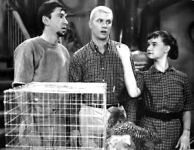  The influences of I Love a Mystery and Dobie Gillis were especially apparent in these early episodes; Mark Evanier, who would write Scooby-Doo teleplays and comic book scripts in the 1970s and 1980s, identified each of the four teenagers with their corresponding Dobie Gillis character: "Fred was based on Dobie, Velma on Zelda, Daphne on Thalia and Shaggy on Maynard." The similarities between Shaggy and Maynard are the most noticeable; both characters share the same beatnik-style goatee, similar hairstyles, and demeanours. The roles of each character are strongly defined in the series: Fred is the leader and the determined detective, Velma is the intelligent analyst, Daphne is danger-prone and vain, and Shaggy and Scooby-Doo are cowardly types more motivated by hunger than any desire to solve mysteries. Later versions of the show would make slight changes to the characters' established roles, most notably in the character of Daphne, shown in 1990s and 2000s Scooby-Doo productions as knowing many forms of karate and being able to defend herself. The influences of I Love a Mystery and Dobie Gillis were especially apparent in these early episodes; Mark Evanier, who would write Scooby-Doo teleplays and comic book scripts in the 1970s and 1980s, identified each of the four teenagers with their corresponding Dobie Gillis character: "Fred was based on Dobie, Velma on Zelda, Daphne on Thalia and Shaggy on Maynard." The similarities between Shaggy and Maynard are the most noticeable; both characters share the same beatnik-style goatee, similar hairstyles, and demeanours. The roles of each character are strongly defined in the series: Fred is the leader and the determined detective, Velma is the intelligent analyst, Daphne is danger-prone and vain, and Shaggy and Scooby-Doo are cowardly types more motivated by hunger than any desire to solve mysteries. Later versions of the show would make slight changes to the characters' established roles, most notably in the character of Daphne, shown in 1990s and 2000s Scooby-Doo productions as knowing many forms of karate and being able to defend herself.
The plot of each Scooby-Doo episode followed a formula that would serve as a template for many of the later incarnations of the series. At the beginning of the episode, the Mystery, Inc. gang bump into some type of evil ghost or a monster, which they learn has been terrorizing the local populace. The teens offer to help solve the mystery behind the creature, but while looking for clues and suspects, the gang (and in particular Shaggy and Scooby) run into the monster, who always gives chase. However, after analyzing the clues they have found, the gang determines that this monster is simply a mere mortal in disguise. They capture the monster and have the criminal behind the mask or costume arrested. At this point, the criminal would utter the famous catchphrase, or a variation thereof: "I would have gotten away with it if it wasn't for you meddling kids!"
 Scooby-Doo, Where Are You! was a major ratings success for CBS, and they renewed it for a second season in 1970. The eight 1970 episodes of Scooby-Doo, Where Are You! differed slightly from the first-season episodes in their uses of more slapstick humor, Archie Show-like "chase songs" during climactic sequences, Heather North performing the voice of Daphne in place of Christopherson, and a re-recorded theme song. Both seasons contained a laugh track, which was the standard practice for U.S. cartoon series during the 1960s and 1970s. Scooby-Doo, Where Are You! was a major ratings success for CBS, and they renewed it for a second season in 1970. The eight 1970 episodes of Scooby-Doo, Where Are You! differed slightly from the first-season episodes in their uses of more slapstick humor, Archie Show-like "chase songs" during climactic sequences, Heather North performing the voice of Daphne in place of Christopherson, and a re-recorded theme song. Both seasons contained a laugh track, which was the standard practice for U.S. cartoon series during the 1960s and 1970s.
 In 1972, after 25 half-hour episodes, the program was doubled to a full hour and called The New Scooby-Doo Movies; each episode of which featured a different guest star helping the gang solve mysteries. Among the most notable of these guest stars were The Harlem Globetrotters, The Three Stooges, Don Knotts, and Batman & Robin, who all appeared at least twice on the show. After two seasons and 24 episodes of the New Movies format from 1972 to 1974, the show went to reruns of the original series until Scooby moved to ABC in 1976. In 1972, after 25 half-hour episodes, the program was doubled to a full hour and called The New Scooby-Doo Movies; each episode of which featured a different guest star helping the gang solve mysteries. Among the most notable of these guest stars were The Harlem Globetrotters, The Three Stooges, Don Knotts, and Batman & Robin, who all appeared at least twice on the show. After two seasons and 24 episodes of the New Movies format from 1972 to 1974, the show went to reruns of the original series until Scooby moved to ABC in 1976.
|
The ABC Years
 On ABC, the show went through almost yearly format changes. For their 1976 - 1977 season, new episodes of Scooby-Doo were joined with a new H-B show, Dynomutt, Dog Wonder, to create The Scooby-Doo/Dynomutt Hour (It became The Scooby-Doo/Dynomutt Show when a bonus Scooby-Doo, Where are You! rerun was added to it in November 1976). This hour-long package show later evolved into the longer programming blocks Scooby's All-Star Laff-a-Lympics (1977 - 1978) and Scooby's All-Stars (1978 - 1979). On ABC, the show went through almost yearly format changes. For their 1976 - 1977 season, new episodes of Scooby-Doo were joined with a new H-B show, Dynomutt, Dog Wonder, to create The Scooby-Doo/Dynomutt Hour (It became The Scooby-Doo/Dynomutt Show when a bonus Scooby-Doo, Where are You! rerun was added to it in November 1976). This hour-long package show later evolved into the longer programming blocks Scooby's All-Star Laff-a-Lympics (1977 - 1978) and Scooby's All-Stars (1978 - 1979).
New Scooby episodes, in the original Scooby-Doo, Where Are You! format, were produced for each of these three seasons. Four of these episodes featured Scooby's dim-witted country cousin Scooby-Dum as a semi-regular character. The Scooby-Doo episodes produced during these three seasons were later packaged together for syndication as The Scooby-Doo Show, under which title they continue to air.
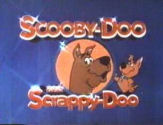 In 1979, Scooby's tiny nephew Scrappy-Doo was added to both the series and the billing, in an attempt to boost Scooby-Doo's slipping ratings. The 1979–1980 episodes, aired under the title Scooby-Doo and Scrappy-Doo, succeeded in regenerating interest in the show, and as a result, the entire show was overhauled in 1980 to focus on Scrappy-Doo. Fred, Daphne, and Velma were dropped from the series, and the new Scooby-Doo and Scrappy-Doo format was now comprised of three seven-minute comedic adventures starring Scooby, Scrappy, and Shaggy instead of one half-hour mystery. This version of Scooby-Doo and Scrappy-Doo aired as part of The Richie Rich/Scooby-Doo Show from 1980 to 1982, and as part of The Scooby-Doo/Scrappy-Doo/Puppy Hour from 1982 to 1983. Most of the supernatural villains in the seven-minute Scooby and Scrappy cartoons, who in previous Scooby series had been revealed to be human criminals in costume, were now "real" within the context of the series. In 1979, Scooby's tiny nephew Scrappy-Doo was added to both the series and the billing, in an attempt to boost Scooby-Doo's slipping ratings. The 1979–1980 episodes, aired under the title Scooby-Doo and Scrappy-Doo, succeeded in regenerating interest in the show, and as a result, the entire show was overhauled in 1980 to focus on Scrappy-Doo. Fred, Daphne, and Velma were dropped from the series, and the new Scooby-Doo and Scrappy-Doo format was now comprised of three seven-minute comedic adventures starring Scooby, Scrappy, and Shaggy instead of one half-hour mystery. This version of Scooby-Doo and Scrappy-Doo aired as part of The Richie Rich/Scooby-Doo Show from 1980 to 1982, and as part of The Scooby-Doo/Scrappy-Doo/Puppy Hour from 1982 to 1983. Most of the supernatural villains in the seven-minute Scooby and Scrappy cartoons, who in previous Scooby series had been revealed to be human criminals in costume, were now "real" within the context of the series.
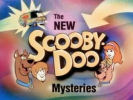 In 1984, the series brought Daphne back into the show to accompany Shaggy, Scooby and Scrappy and brought back the half-hour mystery formula in The New Scooby-Doo Mysteries. In 1984, the series brought Daphne back into the show to accompany Shaggy, Scooby and Scrappy and brought back the half-hour mystery formula in The New Scooby-Doo Mysteries.
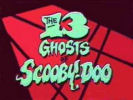 1985 saw the debut of The 13 Ghosts of Scooby-Doo, which featured Daphne, Shaggy, Scooby, Scrappy, and new characters Flim-Flam and Vincent Van Ghoul (based upon and voiced by Vincent Price) traveling the globe to capture "thirteen of the most terrifying ghosts and ghouls on the face of the earth." The 13 Ghosts of Scooby-Doo was cancelled in March 1986, which was followed with "The New Scooby and Scrappy Doo Show" later that Fall, and no new Scooby series aired on the network for the next two years, though during that time period, best-of episode aired under the "Scooby-Doo Mystery Funhouse" package. 1985 saw the debut of The 13 Ghosts of Scooby-Doo, which featured Daphne, Shaggy, Scooby, Scrappy, and new characters Flim-Flam and Vincent Van Ghoul (based upon and voiced by Vincent Price) traveling the globe to capture "thirteen of the most terrifying ghosts and ghouls on the face of the earth." The 13 Ghosts of Scooby-Doo was cancelled in March 1986, which was followed with "The New Scooby and Scrappy Doo Show" later that Fall, and no new Scooby series aired on the network for the next two years, though during that time period, best-of episode aired under the "Scooby-Doo Mystery Funhouse" package.
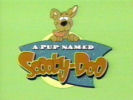 Hanna-Barbera reincarnated the original Scooby-Doo, Where Are You! cast as junior high school students for A Pup Named Scooby-Doo, which debuted on ABC in 1988. A Pup Named Scooby-Doo was an irreverent, zany re-imagining of the series, heavily inspired by the classic cartoons of Tex Avery and Bob Clampett, and eschewed the quasi-reality of the original Scooby series for a more Looney Tunes-like style. The retooled show was a success, and lasted until 1991. Hanna-Barbera reincarnated the original Scooby-Doo, Where Are You! cast as junior high school students for A Pup Named Scooby-Doo, which debuted on ABC in 1988. A Pup Named Scooby-Doo was an irreverent, zany re-imagining of the series, heavily inspired by the classic cartoons of Tex Avery and Bob Clampett, and eschewed the quasi-reality of the original Scooby series for a more Looney Tunes-like style. The retooled show was a success, and lasted until 1991.
|
Reruns and The WB Revival
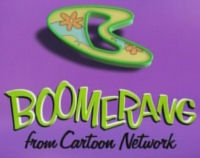 Reruns of the show have been in syndication since the mid-1980s, and have also been shown on cable television networks such as TBS Superstation (until 1989), and USA Network (as part of the USA Cartoon Express from 1990 to 1994). In 1993, A Pup Named Scooby-Doo, having just recently ended its network run on ABC, began reruns on the Cartoon Network; the other versions of Scooby-Doo joined it the following year and became exclusive to Turner networks such as the Cartoon Network, TBS Superstation, and TNT. Canadian network Teletoon began airing Scooby-Doo, Where are You! in 1997, with the other Scooby series soon following. When TBS and TNT ended their broadcasts of H-B cartoons in 1998, Scooby-Doo became the exclusive property of both Cartoon Network and sister station Boomerang. Reruns of the show have been in syndication since the mid-1980s, and have also been shown on cable television networks such as TBS Superstation (until 1989), and USA Network (as part of the USA Cartoon Express from 1990 to 1994). In 1993, A Pup Named Scooby-Doo, having just recently ended its network run on ABC, began reruns on the Cartoon Network; the other versions of Scooby-Doo joined it the following year and became exclusive to Turner networks such as the Cartoon Network, TBS Superstation, and TNT. Canadian network Teletoon began airing Scooby-Doo, Where are You! in 1997, with the other Scooby series soon following. When TBS and TNT ended their broadcasts of H-B cartoons in 1998, Scooby-Doo became the exclusive property of both Cartoon Network and sister station Boomerang.
 In 2002, following the successes of the Cartoon Network reruns and four late-1990s direct-to-video Scooby-Doo releases, the original version of the gang was updated for the 21st century for What's New, Scooby-Doo?, which aired on Kids WB from 2002 until 2005, with second-run episodes also appearing on Cartoon Network. Unlike previous Scooby series, the show was produced at Warner Bros. Television Animation, which had absorbed Hanna-Barbera in 2001. The show returned to the familiar format of the original series for the first time since 1978, with modern-day technology and culture added to the mix to give the series a more contemporary feel, along with new, digitally-recorded sound effects and music. With Don Messick having died in 1997, Frank Welker took over as Scooby's voice actor, while continuing to provide the voice of Fred as well, and Casey Kasem returned as Shaggy. Grey DeLisle now provides the voice of Daphne (she first took the role on Scooby-Doo and the Cyber Chase, replacing Mary Kay Bergman, who committed suicide shortly before the release of Scooby-Doo and the Alien Invaders) and former Facts of Life star Mindy Cohn voices Velma. However, Scooby-Doo himself was very rarely focused on in most of the show's episodes. In 2002, following the successes of the Cartoon Network reruns and four late-1990s direct-to-video Scooby-Doo releases, the original version of the gang was updated for the 21st century for What's New, Scooby-Doo?, which aired on Kids WB from 2002 until 2005, with second-run episodes also appearing on Cartoon Network. Unlike previous Scooby series, the show was produced at Warner Bros. Television Animation, which had absorbed Hanna-Barbera in 2001. The show returned to the familiar format of the original series for the first time since 1978, with modern-day technology and culture added to the mix to give the series a more contemporary feel, along with new, digitally-recorded sound effects and music. With Don Messick having died in 1997, Frank Welker took over as Scooby's voice actor, while continuing to provide the voice of Fred as well, and Casey Kasem returned as Shaggy. Grey DeLisle now provides the voice of Daphne (she first took the role on Scooby-Doo and the Cyber Chase, replacing Mary Kay Bergman, who committed suicide shortly before the release of Scooby-Doo and the Alien Invaders) and former Facts of Life star Mindy Cohn voices Velma. However, Scooby-Doo himself was very rarely focused on in most of the show's episodes.
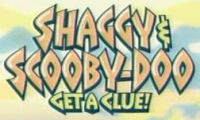 After three seasons, What's New, Scooby-Doo was replaced in September 2006 with Shaggy & Scooby-Doo Get a Clue!, a major revamping of the series which debuted on The CW's Kids' WB Saturday morning programming block. The premise centers around Shaggy inheriting money and a mansion from an uncle, an inventor who has gone into hiding from villains trying to steal his secret invention. The villains, led by "Dr. Phibes" (based primarily upon Dr. Evil from the Austin Powers series), then use different schemes to try to get the invention from Shaggy and Scooby, who handle the plots alone. Fred, Daphne, and Velma are normally absent, but do make appearances at times to help. The characters were redesigned and the art style revised for the new series. After three seasons, What's New, Scooby-Doo was replaced in September 2006 with Shaggy & Scooby-Doo Get a Clue!, a major revamping of the series which debuted on The CW's Kids' WB Saturday morning programming block. The premise centers around Shaggy inheriting money and a mansion from an uncle, an inventor who has gone into hiding from villains trying to steal his secret invention. The villains, led by "Dr. Phibes" (based primarily upon Dr. Evil from the Austin Powers series), then use different schemes to try to get the invention from Shaggy and Scooby, who handle the plots alone. Fred, Daphne, and Velma are normally absent, but do make appearances at times to help. The characters were redesigned and the art style revised for the new series.
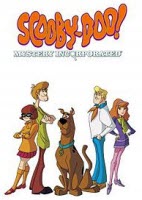 Scooby-Doo! Mystery Incorporated, premiered April 5, 2010, with Matthew Lillard (the actor who played Shaggy in the live-action theatrical films) replacing Kasem as the voice of Shaggy (though Casey Kasem performs the voice for Shaggy's father on the show). The rest of the voice cast was retained from What's New, Scooby-Doo?. The series under the guidance of Supervising Producers Tony Cervone & Spike Brandt, and Producer Mitch Watson still follows the basic mystery-solving format of its predecessors, but now adds a serial format in which each successive episode reveals a portion of a greater secret, as well as romantic relationships between the lead characters and even several darker or suggestively implied concepts not previously explored in the franchise. Episodes are presented as numbered chapters and serious subject-maters such as actual permanent character deaths occur. Scooby-Doo! Mystery Incorporated, premiered April 5, 2010, with Matthew Lillard (the actor who played Shaggy in the live-action theatrical films) replacing Kasem as the voice of Shaggy (though Casey Kasem performs the voice for Shaggy's father on the show). The rest of the voice cast was retained from What's New, Scooby-Doo?. The series under the guidance of Supervising Producers Tony Cervone & Spike Brandt, and Producer Mitch Watson still follows the basic mystery-solving format of its predecessors, but now adds a serial format in which each successive episode reveals a portion of a greater secret, as well as romantic relationships between the lead characters and even several darker or suggestively implied concepts not previously explored in the franchise. Episodes are presented as numbered chapters and serious subject-maters such as actual permanent character deaths occur.
The series, which is the first Scooby-Doo series to directly debut on cable television, is considered a "reboot" of the franchise, and as such, the producers and creative team are not beholden to previously established continuity from other Scooby-Doo series. Though Scooby-Doo! Mystery Incorporated does reference concepts, characters, and aspects from not only older Scooby-Doo shows but also from other Hanna-Barbara properties as well, it utilizes them in new fashions that maintains the essence of familiarity while not being strictly tied to what has come before. To ease in explaining the creative approach to the series, Supervising Producer Tony Cervone has proclaimed that Scooby-Doo! Mystery Incorporated takes place in it's own "Alternate Universe separate from all previous shows and current direct to DVD movies."
Scooby-Doo! Mystery Incorporated has been planned to run for 52 episodes spread out over two 26 episode seasons, though oddly placed and lengthy hiatuses have occurred which blur the traditional television season structure.
The series aired it's last episode on April 5, 2013.
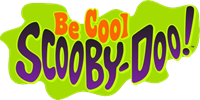 Be Cool, Scooby-Doo first aired on Cartoon Network on October 5, 2015. Written by Jon Colton Barry and Zac Moncrief, who brought us Phineas & Ferb, the show brings a more comedic approach to the gang. In the show, the Scooby-Doo gang decide to travel during their last summer break together, encountering havoc-wreaking monsters along the way. Described as having a more comedic tone than its previous incarnation, the show employs character traits from the original 1969 series on top of redesigned character models. Zac Moncrief described this as a "simplistic, edgy design to match the comedic styling of this latest version." Be Cool, Scooby-Doo first aired on Cartoon Network on October 5, 2015. Written by Jon Colton Barry and Zac Moncrief, who brought us Phineas & Ferb, the show brings a more comedic approach to the gang. In the show, the Scooby-Doo gang decide to travel during their last summer break together, encountering havoc-wreaking monsters along the way. Described as having a more comedic tone than its previous incarnation, the show employs character traits from the original 1969 series on top of redesigned character models. Zac Moncrief described this as a "simplistic, edgy design to match the comedic styling of this latest version."
This marks the first Scooby-Doo television series not to feature Casey Kasem in any capacity. It is also the first series since A Pup Named Scooby-Doo where Velma is voiced by an actress other than Mindy Cohn, and marks the debut of Kate Micucci as the character's voice actress.
The series ended on March 18, 2018 with a total of 52 episodes.
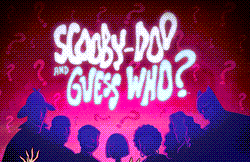 Scooby-Doo and Guess Who? is the 13th television series in the Scooby-Doo franshise, first airing on Boomerang on Demand on June 27, 2019. The series is a more modern version of The New Scooby-Doo Movies, focusing on the Mystery Inc. gang as they solve mysteries while encountering and being assisted by various celebrities and fictional characters. Scooby-Doo and Guess Who? is the 13th television series in the Scooby-Doo franshise, first airing on Boomerang on Demand on June 27, 2019. The series is a more modern version of The New Scooby-Doo Movies, focusing on the Mystery Inc. gang as they solve mysteries while encountering and being assisted by various celebrities and fictional characters.
The series made its Cartoon Network debut on July 8, 2019 and aired on the Boomerang channel on October 1, 2020. There are currently 41 episodes in the series.
|
| Source Info: Most information for the history was taken from Wikipedia. Write-up on SDMI provided by j3h. |
|